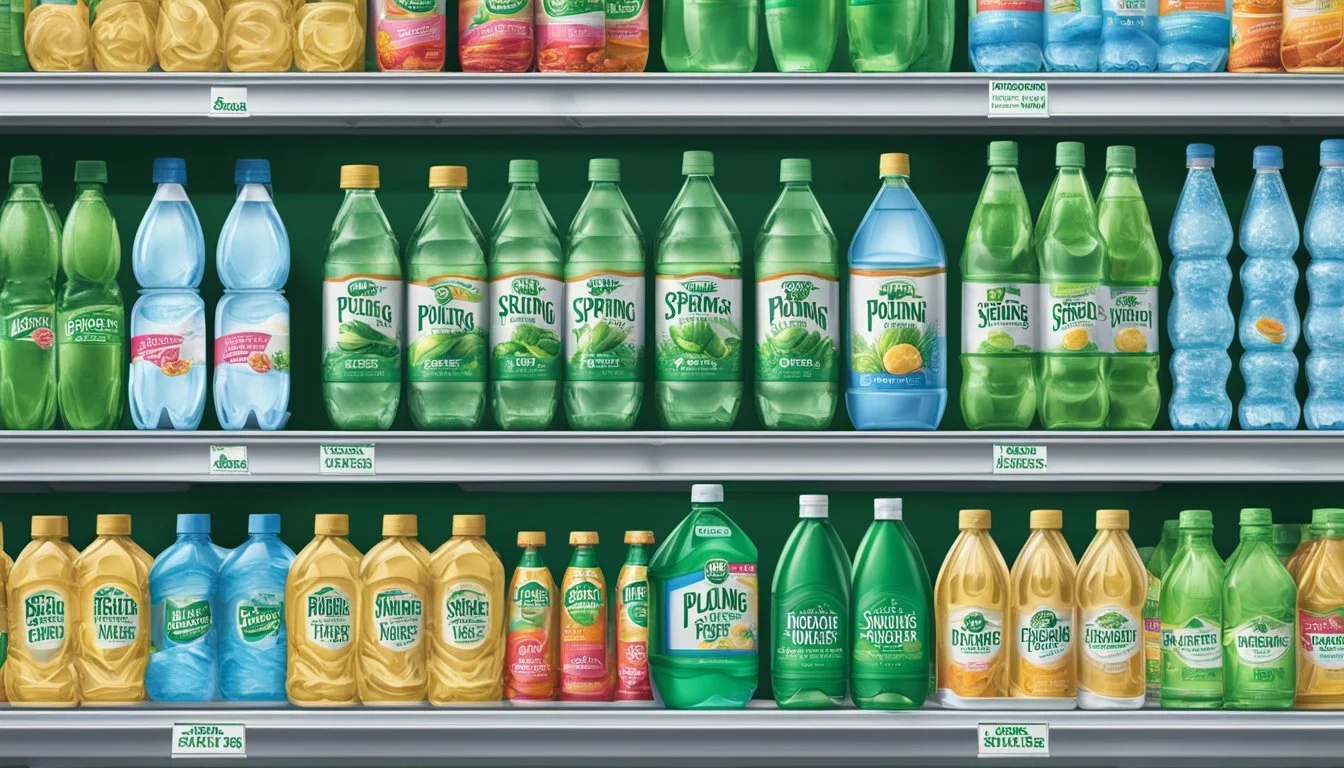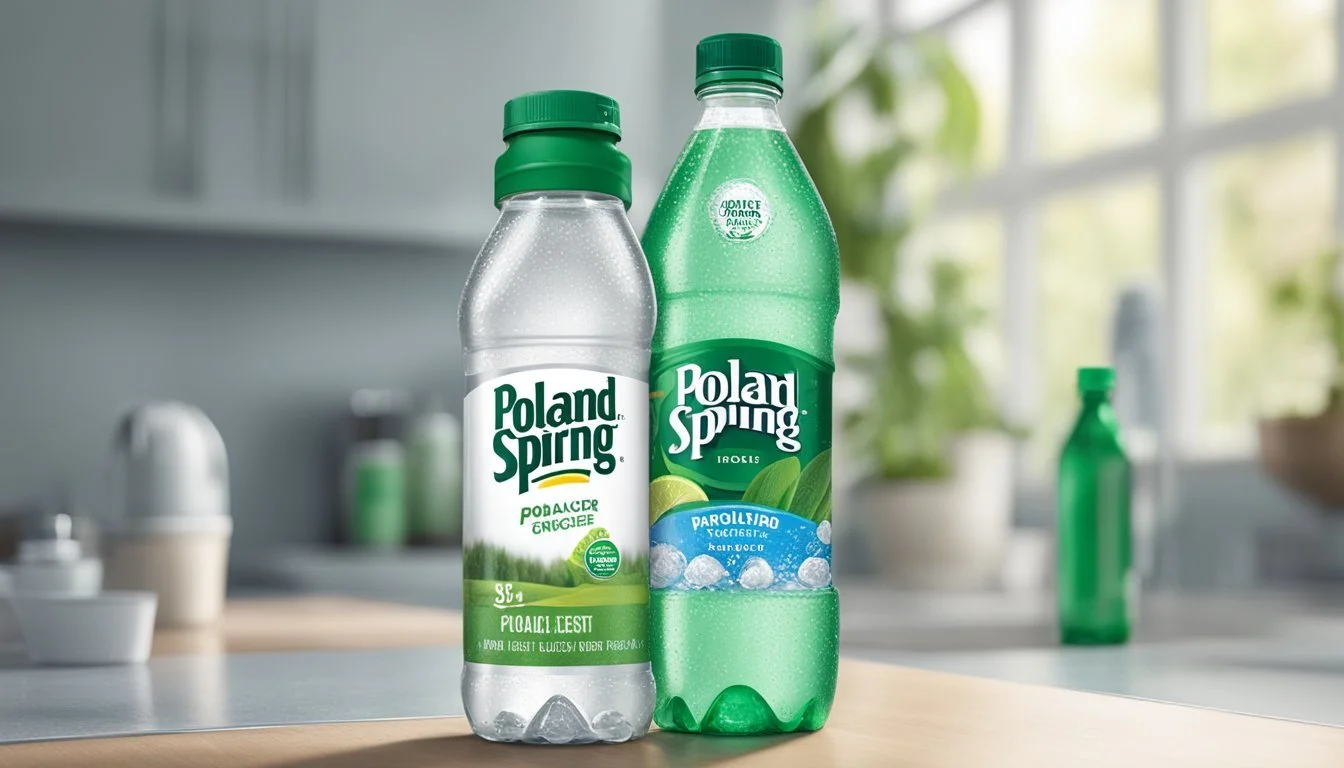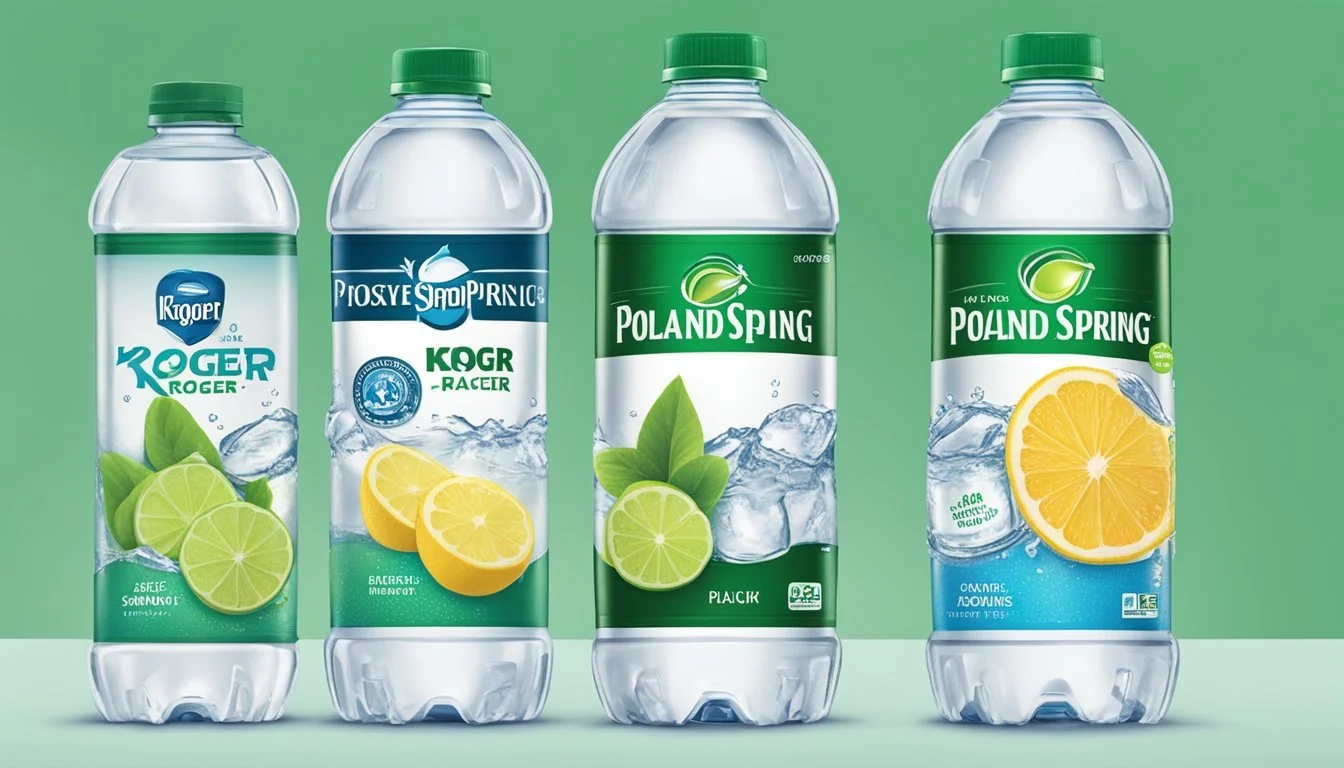Poland Spring vs. Kroger
Which Bottled Water is Better for You?
When it comes to choosing between Poland Spring and Kroger bottled water, many consumers are curious about which option is superior. Poland Spring, sourced from multiple springs in Maine, boasts a reputation for natural spring water with a crisp, refreshing taste. On the other hand, Kroger's bottled water offers an economical choice, often appealing to budget-conscious shoppers looking for basic hydration at a lower price point.
Both brands bring their own unique qualities to the table, but the decision ultimately hinges on what the consumer values more—taste and brand reputation or affordability and convenience. Alongside this, factors like mineral content, sourcing practices, and overall consumer satisfaction play crucial roles.
By diving deeper into the specific characteristics and consumer feedback for each brand, readers can make an informed choice that best suits their preferences and needs. This comparison aims to provide clarity and assist in making a well-rounded decision between Poland Spring and Kroger bottled water.
Background on Bottled Water
The bottled water industry has seen significant growth over the years, with various brands carving out niches in the market. Factors such as market dynamics, brand histories, and environmental implications shape the industry landscape.
History and Growth of the Bottled Water Market
Bottled water has evolved from a luxury item in the 1800s to a common household staple today. The practice began with mineral and spring waters marketed for their health benefits.
By the mid-20th century, technological advancements in purification and bottling expanded accessibility. Brands like Poland Spring, originating after the American Civil War, and others have roots tracing back well over a century.
Growth accelerated in the late 20th and early 21st centuries, driven by rising health consciousness and declining trust in public water supplies. Today, bottled water ranks as one of the most consumed beverages globally, with market forecasts predicting continued growth.
Poland Spring and Kroger Water: Brand Profiles
Poland Spring sources its water from multiple springs in Maine. It prides itself on bottling 100% natural spring water. The brand's rich history and regional sourcing make it a significant player, especially in the Northeastern United States.
Kroger Water, produced under the grocery store's private label, offers both purified and spring water varieties. It is widely accessible across the U.S. and often more budget-friendly than national brands like Poland Spring. Quality and consistency are paramount, with stringent controls adhering to both FDA and EPA standards.
Environmental Impact of Bottled Water Production
The environmental footprint of bottled water production is a growing concern. Poland Spring claims to invest in sustainable practices, including reducing plastic use and improving recycling programs. Their commitment to environmentally responsible sourcing is also highlighted.
Kroger engages in similar sustainability efforts, focusing on reducing packaging waste and enhancing efficiency in production. Despite these initiatives, the industry faces criticism over carbon emissions and water resource management.
Consumers are increasingly aware of these issues, prompting brands to adopt greener strategies to mitigate environmental impacts. Balancing the benefits of bottled water with responsible environmental stewardship remains an ongoing challenge.
Health and Safety Standards
Both Poland Spring and Kroger bottled water brands adhere to stringent health and safety standards to ensure consumer safety. This section discusses the FDA regulations, third-party testing, and the EPA's role in maintaining water safety.
FDA Regulations on Bottled Water
The Food and Drug Administration (FDA) regulates bottled water as a packaged food product. This regulation requires bottled water to meet the same standards for contaminants as public drinking water, which includes limits on the levels of certain minerals, bacteria, and chemicals.
Manufacturers, including Poland Spring and Kroger, must adhere to these guidelines to ensure their bottled water is safe for consumption. Moreover, they must follow Good Manufacturing Practices (GMP) to minimize potential contamination during production.
Third-Party Testing and Certification
Third-party testing adds an additional layer of safety and credibility to bottled water products. Both Poland Spring and Kroger utilize third-party laboratories to perform rigorous testing and ensure their products meet or exceed safety standards set forth by the FDA.
For instance, BlueTriton, which owns the Poland Spring brand, uses third-party testing experts to verify its spring water quality. This independent verification helps in maintaining transparency and trust with consumers by confirming that the water is free from harmful contaminants.
The Role of the EPA in Water Safety
The Environmental Protection Agency (EPA) plays a pivotal role in regulating and monitoring public drinking water in the United States. While the EPA does not directly regulate bottled water, its standards for public water supplies set a benchmark that the FDA uses for bottled water regulation.
Poland Spring and Kroger must ensure that their bottled water meets these stringent standards to guarantee safety. Regular testing and compliance with EPA guidelines help in reducing risks associated with contaminants like lead and chlorine byproducts, ensuring the bottled water is both safe and clean for consumers.
Composition and Taste Comparison
Poland Spring and Kroger bottled waters have distinct differences in their composition and taste. Key factors include the source of the water, the mineral content, and how they taste to consumers.
Mineral Content in Poland Spring and Kroger Water
Poland Spring, sourced from natural springs in Maine, embodies a specific mineral profile. It's known for its balanced mineral content, which includes calcium, magnesium, and sodium. This combination contributes to its slightly alkaline pH level, making it a preferred choice for many.
Mineral Poland Spring (mg/L) Calcium 6.6 Magnesium 1.0 Sodium 4.7 Potassium 0.1
Kroger branded water, often sourced from various municipal supplies, usually undergoes a purification process such as reverse osmosis. This process can result in lower mineral content compared to natural spring water. Kroger water might also have added electrolytes like potassium and magnesium to enhance taste.
Mineral Kroger Water (mg/L) Calcium Minimal Magnesium Minimal Sodium 9.0 Potassium 0.2
Tasting Notes: Subjective Assessments
Poland Spring water has a reputation for a clean and crisp taste attributed to its natural mineral composition. The presence of calcium and magnesium adds a subtle flavor that many consumers find refreshing.
Kroger water, due to its purification process, tends to have a neutral taste, free from the nuances found in spring water. Added electrolytes can give Kroger water a slight, albeit artificial, taste profile intended to mimic natural mineral water.
Enthusiasts often describe Poland Spring as having a "natural" and "refreshing" taste, while Kroger is considered "plain" but reliably "consistent." Individual preferences play a significant role in determining the favored option.
Source and Filtration Processes
Poland Spring and Kroger offer bottled water sourced from different locations and subjected to distinct filtration processes. They emphasize purity, taste, and quality by utilizing specific techniques aimed at delivering safe and refreshing water.
Exploring Natural Sources: Springs and Aquifers
Poland Spring sources its water from natural springs in Maine, known for their clean and mineral-rich properties. These springs are fed by aquifers recharged by rainwater and snowmelt, passing through layers of soil and rock such as limestone, which naturally filters impurities. This groundwater source is a cornerstone of Poland Spring's brand identity.
Kroger, on the other hand, often relies on municipal water supplies for its bottled water. Though not sourced from springs, this water goes through extensive treatment processes to ensure safety and quality. The origin of Kroger’s water might not be as pristine as natural springs, but rigorous standards are maintained.
Filtration and Purification Techniques
Poland Spring uses minimal filtration to maintain the natural mineral content and flavor profile derived from its spring sources. The water undergoes basic sediment filtration to remove large particles and bacteria, ensuring it retains its natural essence. The use of UV light purification is common to eliminate any remaining microorganisms without altering taste.
Kroger employs advanced filtration techniques to purify its municipal water source. This includes a multi-step filtration process involving sediment filters, activated carbon filters, and UV light treatment. These steps are designed to remove contaminants such as chlorine, volatile organic compounds (VOCs), and other impurities. The aim is to produce consistent, high-quality purified water.
The Significance of Reverse Osmosis and Deionization
Reverse osmosis (RO) plays a critical role in Kroger's water purification process. RO forces water through a semi-permeable membrane, effectively removing dissolved salts, bacteria, and other contaminants. This results in highly purified water, with an almost neutral taste free from impurities typically found in tap water.
Deionization, another method sometimes used by Kroger, removes ions from water, further purifying it by eliminating minerals. While not as commonly referenced for Poland Spring, these processes highlight the effort Kroger invests in ensuring clean and safe drinking water. Poland Spring's methods hinge more on natural filtration, preserving the water's original mineral content.
Contaminants and Purity Standards
This section compares contaminants and purity standards in Poland Spring and Kroger bottled waters. Key issues include the presence of PFAS chemicals, lead, mercury, and adherence to legal limits.
Understanding PFAS Chemicals and Heavy Metals
Poland Spring and Kroger bottled waters may contain PFAS chemicals (per- and polyfluoroalkyl substances), known for their persistence in the environment and potential health risks. PFAS can accumulate over time, leading to various health issues. Testing has shown that bottled waters, including some popular brands, can contain these chemicals.
Heavy metals like lead and mercury are also concerning. Exposure to lead can result in cognitive deficits, particularly in children, while mercury poisoning can cause neurological and developmental issues. It's important to monitor and control these contaminants in bottled water to ensure safety.
Comparing the Presence of Lead and Mercury
Lead and mercury contamination in bottled water is a serious issue. According to various tests, some bottled water shows detectable levels of these metals. Poland Spring consistently maintains low levels of lead and mercury, adhering to safety guidelines.
Kroger bottled water also meets regulatory standards, but the exact levels can vary based on sourcing and manufacturing practices. Regular testing helps ensure that any slight contamination remains within safe limits, minimizing risks to consumers.
Evaluating Contaminant Levels Against Legal Limits
To secure consumer safety, bottled water must comply with stringent legal limits for contaminants. The FDA and EPA set these limits based on health risk assessments. For instance, lead must not exceed 5 parts per billion (ppb), and mercury is limited to 2 ppb.
Both Poland Spring and Kroger bottled waters are tested to meet these standards. Analytical reports and Consumer Reports testing indicate that both brands remain well within these legal limits for contaminants, reinforcing consumer trust. Regular compliance with these limits ensures both brands prioritize safe, clean drinking water.
Consumer Preferences and Habits
Consumers often choose between different bottled water brands based on their convenience needs and preference for either sparkling or still varieties. This section will explore these key factors in detail.
Convenience Factor: Bottled Water on the Go
Convenience remains a top priority for bottled water consumers. Poland Spring and Kroger both cater to on-the-go lifestyles.
Poland Spring is known for its widespread availability, making it a popular choice among busy individuals. Its bottles come in various sizes from small personal bottles to larger gallon containers.
Kroger bottled water is often found in grocery stores owned by the Kroger Company. The ease of picking it up during a regular shopping trip contributes to its appeal.
Portable packaging and easy access are crucial for consumers seeking hydration options during their daily routines. Both brands benefit from strategic placement in retail locations and effective packaging designs.
Comparison Between Sparkling and Still Water Choices
Consumer preference for sparkling vs. still water varies significantly. Poland Spring primarily focuses on still water, known for its clean taste and natural spring water origins.
In contrast, Kroger offers both still and sparkling water options. This diversity caters to a broader customer base, including those who enjoy the refreshing sensation of carbonated water.
Sparkling water is often preferred for its fizzy texture and flavor options. For instance, flavors like berry or citrus can make hydration more enjoyable.
Still water is typically chosen for its pure and straightforward profile. It is often perceived as a healthier, more natural option.
Poland Spring maintains its reputation for quality and purity, which appeals strongly to still water drinkers. Meanwhile, Kroger’s inclusion of sparkling varieties allows it to capture a different segment of the market.
Economic and Accessibility Considerations
Poland Spring and Kroger bottled waters differ in price and availability, impacting consumer accessibility and budget considerations. Factors such as state distribution and market reach also play significant roles.
Price Point Analysis: Poland Spring vs. Kroger
Poland Spring often commands a higher price point compared to Kroger's store-brand bottled water. This difference can be attributed to Poland Spring's branding, source, and perceived quality.
For instance, a pack of 24 Poland Spring 16.9 oz bottles may range around $5.99-$6.99. Conversely, Kroger’s equivalent pack can often be found at $2.99-$3.99. The lower cost of Kroger water makes it appealing for budget-conscious consumers.
Stores frequently offer promotions, impacting pricing strategies. Kroger's house brand benefits from in-store deals, further driving down costs. Pricing dynamics in this market segment are influenced by regional supply, transportation costs, and local demand.
Availability Across Different States and Markets
Poland Spring has a strong presence in the northeastern United States, where it sources its water. Thus, it is widely available in this region across supermarkets, convenience stores, and online platforms.
Kroger operates numerous stores across multiple states, primarily in the Midwest and South. This extensive network enables widespread availability of Kroger-branded water in these areas.
Due to Poland Spring's regional sourcing, its national availability is more limited. On the other hand, Kroger's expansive retail footprint ensures its water reaches a broader market.
Consumers in regions outside Poland Spring’s primary market may find it less accessible. Meanwhile, Kroger's consistent presence ensures more consistent accessibility across its operational states.
Conclusion
When assessing Poland Spring and Kroger bottled water, few key aspects stand out.
Source: Poland Spring water is sourced from multiple springs in Maine, providing a natural taste profile. Kroger's bottled water comes from municipal sources, which are then purified.
Taste and Purity: Taste varies by individual preference. Some consumers prefer the naturally occurring minerals in Poland Spring, while others appreciate the consistency of taste in Kroger's purified water.
Price: Kroger's bottled water is often more affordable, making it a convenient option for budget-conscious consumers. Poland Spring, while priced higher, offers the assurance of spring water.
Availability: Both brands are widely available across the United States. Poland Spring is more prominent in the Northeast, whereas Kroger’s extensive network makes their bottled water accessible nationwide.
Best Choice: Those who prioritize natural spring water may lean towards Poland Spring. Consumers looking for a cost-effective and reliably purified option may prefer Kroger bottled water.
Table Comparison:
Aspect Poland Spring Kroger Source Natural springs in Maine Municipal sources Taste Naturally mineral-rich Consistently neutral Price Higher Lower Availability Northeast focus Nationwide
Each brand brings distinct qualities, catering to different preferences and needs.
More About Poland Spring
Acqua Panna vs Poland Spring: Which Bottled Water is Better?
Boxed Water vs Poland Spring: Which Bottled Water is Better?
Core Hydration vs Poland Spring: Which Bottled Water is Better?
Ice Mountain vs Poland Spring: Which Bottled Water is Better?
Icelandic Glacial vs Poland Spring: Which Bottled Water is Better?
Mountain Valley Spring Water vs Poland Spring: Which Bottled Water is Better?
Nestle Pure Life vs Poland Spring: Which Bottled Water is Better?
Poland Spring vs Aqua Carpatica: Which Bottled Water is Better?
Poland Spring vs Cascade Mountain: Which Bottled Water is Better?
Poland Spring vs Castle Rock: Which Bottled Water is Better?
Poland Spring vs Crystal Geyser: Which Bottled Water is Better?
Poland Spring vs Crystal Lake: Which Bottled Water is Better?
Poland Spring vs Essence pH10: Which Bottled Water is Better?
Poland Spring vs Hawaii Volcanic: Which Bottled Water is Better?
Poland Spring vs Hawaiian Springs: Which Bottled Water is Better?
Poland Spring vs Kirkland Signature: Which Bottled Water is Better?
Poland Spring vs Liquid Death: Which Bottled Water is Better?
Poland Spring vs Proud Source: Which Bottled Water is Better?
Poland Spring vs Purely Sedona: Which Bottled Water is Better?
Poland Spring vs Richard's Rainwater: Which Bottled Water is Better?
Poland Spring vs San Pellegrino: Which Bottled Water is Better?
Poland Spring vs Simple Truth: Which Bottled Water is Better?
Poland Spring vs Solan de Cabras: Which Bottled Water is Better?
Poland Spring vs Talking Rain AQA: Which Bottled Water is Better?
Poland Spring vs Weird Water: Which Bottled Water is Better?
Poland Spring vs Whole Foods 365: Which Bottled Water is Better?
Poland Spring vs Whole Foods Italian Still Mineral water: Which Bottled Water is Better?
Poland Spring vs Zephyrhills: Which Bottled Water is Better?






